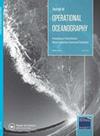全球变化沿海观测站的低成本长期模型
IF 2.4
3区 地球科学
Q4 METEOROLOGY & ATMOSPHERIC SCIENCES
引用次数: 5
摘要
全球变化(包括气候变化)的识别和量化需要长时间序列的关键变量。本文介绍了低成本沿海长期观测站的基本原理和运行情况,并给出了初步数据。愿景是提供一个至少在未来100年的理化数据科学平台,这需要建立可持续的战略,培训人力资源,强大的制度支持和长期的资金来源。该网络自2013年正式运营以来,已产生超过600万个数据点,并不断增长,其中150万个数据点永久存储,并通过公共访问web平台提供。描述了策略和方法,并在马萨特兰天文台介绍了8个环境变量的数据恢复和基本统计。2015年是极端厄尔尼诺Niño年,从海湾到乌里亚斯中部沿海泻湖的海洋温度升高,高于大气温度,并显示出火力发电厂的影响。在马萨特兰湾的地表水中,也观察到缺氧期。预期结果将促进其他项目的发展,并将对科学界和决策者有用,以更好地管理全世界的沿海生态系统。本文章由计算机程序翻译,如有差异,请以英文原文为准。
A low-cost long-term model of coastal observatories of global change
ABSTRACT The identification and quantification of global change, including climate change, requires long time series of key variables. In this work, the fundamentals and operation of low-cost long-term coastal observatories are described, and preliminary data are shown. The vision is to offer a scientific platform of physicochemical data for at least the next 100 years, what requires establishing sustainable strategies, training human resources, strong institutional support, and long-term funding sources. The network formally operates since 2013 and has generated more than 6 million data points, continuously growing, of which >1.5 million data points are permanently stored and available through a public access web platform. The strategies and methodologies are described and, in the Mazatlan observatory, data recovery and basic statistics of eight environmental variables are presented. During 2015, an extreme El Niño year, marine temperatures increased from the bay to the middle Urias coastal lagoon, were higher than atmospheric temperatures, and showed the impact of a thermal power plant. In surface waters of Mazatlan bay, hypoxic periods were also observed. It is expected that results will foster the development of other projects, and will be useful to the scientific community and decision makers, for a better management of coastal ecosystems worldwide.
求助全文
通过发布文献求助,成功后即可免费获取论文全文。
去求助
来源期刊
CiteScore
7.50
自引率
9.70%
发文量
8
审稿时长
>12 weeks
期刊介绍:
The Journal of Operational Oceanography will publish papers which examine the role of oceanography in contributing to the fields of: Numerical Weather Prediction; Development of Climatologies; Implications of Ocean Change; Ocean and Climate Forecasting; Ocean Observing Technologies; Eutrophication; Climate Assessment; Shoreline Change; Marine and Sea State Prediction; Model Development and Validation; Coastal Flooding; Reducing Public Health Risks; Short-Range Ocean Forecasting; Forces on Structures; Ocean Policy; Protecting and Restoring Ecosystem health; Controlling and Mitigating Natural Hazards; Safe and Efficient Marine Operations

 求助内容:
求助内容: 应助结果提醒方式:
应助结果提醒方式:


